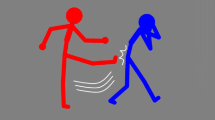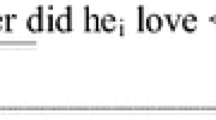Abstract
The present study investigated scrambling effects on the processing of Japanese sentences and priority information used among thematic roles, case particles and grammatical functions. Reaction times for correct sentence decisions were significantly prolonged for scrambled active sentences with transitive verbs in the first experiment and with ditransitive verbs in the second experiment. Errors were made with scrambled sentences more than canonical sentences in both experiments, which suggested that scrambling effects were apparent in active sentences. Passive sentences in the third experiment indicated that canonical order defined based on case particles, not thematic roles, was more quickly and accurately identified than scrambled order. Potential sentences in the fourth experiment and causative sentences in the fifth experiment indicated that the processing of scrambled sentences based on grammatical functions, but not on case particles, required longer reaction times and resulted in higher error rates than canonical sentences. Consequently, scrambling effects in the present study indicated that neither thematic roles nor case particles can provide fully-satisfactory information for canonical phrase order, and that only grammatical functions offer satisfactory information in all types of sentences.
Similar content being viewed by others
Explore related subjects
Discover the latest articles and news from researchers in related subjects, suggested using machine learning.References
N. Amano K. Kondo (2000) Nihongo-no goi tokusei [Lexical Properties of Japanese] Sanseido Tokyo
Aoshima, S., Phillips, C., & Weinberg, A. (2002). Active filler effects and reanalysis: A study of Japanese Wh-scrambling constructions. University of Maryland Working Papers in Linguistics, 12, 1–24.
N. Chomsky (1981) Lectures on Government and Binding Foris Publications Dordrecht, the Netherlands
K. Chujo (1983) ArticleTitleNihongo tanbun-no rikai katei—Bunrikai sutoratejii no sougo kankei [The interrelationships among strategies for sentence comprehension] Japanese Journal of Psychology 54 250–256
A. Farmar (1984) Modularity in Syntax: A Study of Japanese and English MIT Press Cambridge, MA
L. Frazier C. Clifton SuffixJr. (1989) ArticleTitleSuccessive cyclicity in the grammar and the parser Language and Cognitive Processes 4 93–126
L. Frazier d’Arcais Flores (1989) ArticleTitleFiller-driven parsing: A study of gap filling in Dutch Journal of Memory and Language 28 331–344 Occurrence Handle10.1016/0749-596X(89)90037-5
N. Fukui (1989) Nichi/ei-go hikaku toogo-ron [Contrastive syntax of Japanese and English] K. Inoue (Eds) Nihon bunpoo shoo-jiten [The small dictionary of Japanese grammar] Taishukan Shoten Tokyo 89–108
N. Fukui (1988) ArticleTitleDeriving the differences between English and Japanese: A case study in parametric syntax English Linguistics 5 249–270
N. Fukui (1995) The Theory of Projection in Syntax Kuroshio Shuppan Tokyo
K. Hale (1980) ArticleTitleRemarks on Japanese Phrase Structure: Comments on the papers on Japanese Syntax MIT Working Papers in Linguistics 2 185–203
K. Hale (1981) On the Position of Warlpiri in a Typology of the Base IULC Bloomington, IN
S.-I. Harada (1977) ArticleTitleNihongo-ni ‘Henkei’-wa Hitsuyooda Gengo [Lanugage] 10 88–95
N. Hasegawa (1999) Seisei nihongogaku nyuumon [An Introduction to Generative Grammar of the Japanese Language] Taishukan Shoten Tokyo
H Hoji (1985) Logical Form Constraints and Configurational Structure in Japanese University of Washington Seattle
K. Inoue K. Harada Y. Abe (1999) Seisei gengogaku nyuumon [An Introduction to Generative Linguistics] Taishukan Shoten Tokyo
A. Mahajan (1990) The A/A-Bar Distinction and Movement Theory Massachusetts Institute of Technology Cambridge
R. Mazuka K. Itoh T. Kondo (2002) Costs of scrambling in Japanese sentence processing M. Nakayama (Eds) Sentence Processing in East Asian Languages CSLI Publications Stanford, CA 131–166
S. Miyagawa (1989) Structure and Case Marking in Japanese—Syntax and Semantics Academic Press San Diego, CA
E.T. Miyamoto S. Takahashi (2004) ArticleTitleFiller-gap dependencies in the processing of scrambling in Japanese Language and Linguistics 5 153–166
E. T. Miyamoto (2004) Processing alternative word orders in Japanese M. Nakayama R. Mazuka Y. Shirai P. Li (Eds) Handbook of East Asian Psycholinguistics: Japanese Cambridge University Press Cambridge, MA
G. Müller S. Wolfgang (1994) Scrambling as A-bar movement N. Corver H. Riemsdijk Particlevan (Eds) Studies on Scrambling Mouton de Gruyter Berlin 331–385
M. Nakayama (1995) Scrambling and probe recognition R. Mazuka N. Nagai (Eds) Japanese Sentence Processing Erlbaum Hillsdale NJ 257–273
M. Nakayama (1999) Sentence processing M. Tsujimura (Eds) The Handbook of Japanese Linguistics Blackwell Publishers Malden, Massachusetts 398–424
N. Nemoto (1999) Scrambling M. Tsujimura (Eds) The Handbook of Japanese Linguistics Blackwell Publishers Malden Massachusetts 121–153
J.-R. Ross (1967) Constraints on Variables in Syntax Massachusetts Institute of Technology Cambridge
M. Saito (1985) Some Asymmetries in Japanese and Their Theoretical Implications Massachusetts Institute of Technology Cambridge
M. Saito H. Hoji (1983) ArticleTitleWeak cross-over and move α in Japanese Natural Language and Linguistic Theory 1 245–259 Occurrence Handle10.1007/BF00154832
T. Sakamoto (2001) ArticleTitleBun-no rikai—kakimaze bun [Understanding of Sentences—Scrambling] Gengo [Language] 30 IssueID10 106–111
T. Sakamoto (2002) Processing filler-gap constructions in Japanese M. Nakayama (Eds) Sentence Processing in East Asian Languages CSLI Publications Stanford, CA 189–221
M. Shibatani (1978) Nihongo no bunseki [Analysis of the Japanese Language] Taishukan Shoten Tokyo
K. Tamaoka H. Sakai J. Kawahara Y. Miyaoka (2003) ArticleTitleThe effects of phrase-length order and scrambling in the processing of visually-presented Japanese sentences Journal of Psycholinguistic Research 32 431–454 Occurrence Handle10.1023/A:1024851729985 Occurrence Handle12964524
S. Tonoike (1997) On scrambling—Scrambling as a base-generated scopal construction S. Tonoike (Eds) Scrambling Kurosiho Shuppan Tokyo 125–159
G. Webelhuth (1989) Syntactic Saturation Phenomena and the Modern Germanic Languages University of Massachusetts Amherst
H. Ura (1999) ArticleTitleChecking theory and dative subject constructions in Japanese and Korean Journal of East Asian Linguistics 8 223–254 Occurrence Handle10.1023/A:1008383332362
H. Yamashita (1997) ArticleTitleThe effects of word-order and case marking information on the processing of Japanese Journal of Psycholinguistic Research 26 163–188 Occurrence Handle10.1023/A:1025009615473
Author information
Authors and Affiliations
Corresponding author
Rights and permissions
About this article
Cite this article
Tamaoka, K., Sakai, H., Kawahara, Ji. et al. Priority Information Used for the Processing of Japanese Sentences: Thematic Roles, Case Particles or Grammatical Functions?. J Psycholinguist Res 34, 281–332 (2005). https://doi.org/10.1007/s10936-005-3641-6
Issue Date:
DOI: https://doi.org/10.1007/s10936-005-3641-6




